SPECIAL TOOL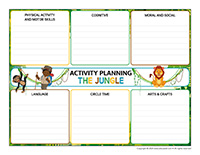
Interactive planning-The jungle
(Open interactive planning-The jungle) Type your activities in the document and print it. Use the document to organize and present educational activities related to the theme.
CIRCLE TIME
Ask each child to share a book, stuffed animal, movie, figurine, or other object which represents the jungle with the group. Deposit all the items in the centre of your circle time area. Discuss each item. Read “The Jungle Book” or watch part of the movie.
AREA SETUP
Educa-decorate-The jungle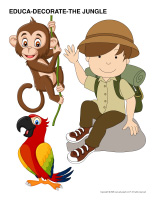
(Open educa-decorate-The jungle) Print, cut out, and laminate the illustrations. Use them to decorate your walls or hang them from the ceiling.
Educa-theme- The jungle
(Open educa-theme-The jungle) Print and laminate the elements representing the theme. Use them to present the theme to your group while decorating your daycare.
Garland-The jungle
(Open models-Jungle animals) Print. Let children decorate the animals and use them to make a garland. Hang it within the daycare.
Transform your lunch area. Set a green tablecloth on the table. (Open zoo animal models) Print and trace the animal models on construction paper. Cut them out and fold them where indicated. Add the missing details (eyes, mouth) directly on the animal shapes. Use pipe cleaners for the ears and tails. Use the animals to create a centerpiece or hang them over your table using transparent thread. You can cut a green plastic tablecloth into strips and hang them from the ceiling to represent lianas.
PICTURE GAME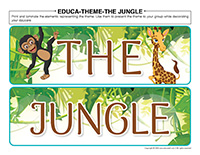
The pictures may be used as a memory game or to spark a conversation with your group. Use them to decorate the daycare or a specific thematic corner. (Open picture game-The jungle) Print, laminate, and store in a Ziploc bag or in your thematic bin.
WRITING ACTIVITY
(Open writing activities-J like jungle) Print for each child or laminate for use with a dry-erase marker.
Stationery-The jungle
(Open stationery-The jungle) Print and use to communicate with parents, in your reading and writing area, or to identify your thematic bins.
ACTIVITY SHEET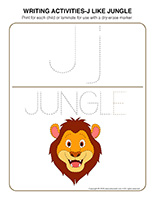
(Open activity sheets-The jungle) Print and follow instructions.
FINE MOTOR SKILLS ACTIVITY SHEET
(Open fine motor skills activity sheets-The jungle) Print. Encourage children to complete the activity sheet.
OBSERVATION SHEET
(Open observation sheet-Circle) Print for each child or laminate for use with a dry-erase marker.
Educa-nuudles-The jungle
(Open educa-nuudles-The jungle) Print for each child. Have children color the activity sheet and use Magic Nuudles to give it a three-dimensional look. Variation: If you do not have Magic Nuudles, simply have children fill the spaces with bingo markers or stickers. To purchase Magic Nuudles:
LANGUAGE ACTIVITIES
Word flashcards-The jungle
The flashcards may be used to spark a conversation with your group, in your reading and writing area, or even to identify your thematic bins. (Open word flashcards-The jungle) liana, panther, tiger, lion, monkey, tree, parrot, elephant, snake, giraffe, zebra, hippopotamus
VARIOUS WORKSHOPS
Have fun with these wonderful workshop ideas provided by Caroline Allard.
Construction/building blocks:
- Decorate the area with pictures of animals which can be seen at the zoo. You can find beautiful calendars at the dollar store. They often have animal pictures which can be used for this theme.
- Make all the animal figurines you have available to the children: wild animals, aquatic animals, polar animals, farm animals, reptiles, etc.
- Figurines can represent visitors or travellers.

- Blocks can be used to build huts and shelters for people or animals.
- A mat with various animals on it.
Arts & crafts:
- A large quantity of Popsicle sticks and white glue. Children can build cages for animals.
- Orange, yellow, brown, and black construction paper can be used to create animals. Children can make collages or three-dimensional animals using empty toilet paper rolls.
- A Frisette lion: Paint an empty toilet paper roll with lion-like colours. Allow to dry. Make four small holes in the roll: two in front and two in the back. Insert one pipe cleaner for the front legs and one for the back legs. Use a small Styrofoam coffee glass and cut it in half horizontally. Cut it vertically to form the lion’s mane. Fold then paint the mane and the bottom of the glass which represents the lion’s face. Allow to dry. Don’t forget to put glue on the inside of the glass first. Your lion is ready!
- Old magazines (such as National Geographic) with pictures of zoo animals can be cut to create a giant collective collage.
- Strips of orange, black, and white paper to make children’s favourite animals.
- A feather to paint a beautiful bird.
Drawing: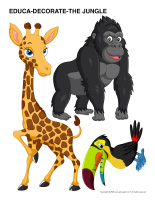
- Zoo animal or zookeeper coloring pages.
- Wild animal stencils.
- Yellow and orange paper for children to draw on using a black pencil.
- Animal shapes for children to trace.
- A sheet of paper divided into two sections: a picture of a zebra in one section, children try to reproduce it in the other section.
Role Play:
- Create a ticket booth. Have children pretend to purchase their ticket to visit the zoo. The zoo can be represented by pictures on the walls. If you have stuffed animals, display them near the pictures.
- The zookeeper will be children’s hero throughout this theme. Have a shirt, pants, a hat, a flashlight, a set of keys, and a mobile phone on hand.
- There is always a veterinarian at the zoo. A white shirt, a stethoscope, a flashlight, a magnifying glass, syringes, and bandages make the perfect costume.
- There must also be a cook for the animals...your traditional kitchen area can be transformed for the theme. When you think of it, what do monkeys, lions, and snakes eat?
- Someone has to clean out the animals’ cages! Have work clothes, a broom, a pail, and brushes of all sizes on hand for this job!
- Build your own cave using a large box.
- Makeup pencils.
Manipulation: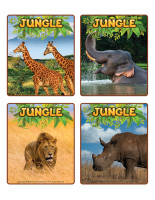
- Memory game with zoo animals. There are many in stores or use educatall pictures.
- Modeling dough with cookie cutters shaped like zoo animals. You may also use dough which hardens when exposed to air and have children sculpt their favourite zoo animal.
- Many different fabrics or fur to touch and manipulate (fake fur, velvet...)
- Board games or lotto games involving animals.
- Association games. Matching animals to their paw prints.
- Puppets representing zoo animals and a small puppet theatre.
Pre-reading:
- Books about animals.
- Fairytales or fables with zoo animals in the storyline.
- A poster displaying various animal families.
- Animal sounds which can be associated to animal pictures.
- A map of the world with animal pictures which can be associated to the correct continents.
Pre-writing: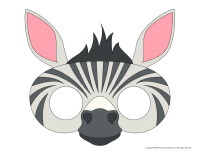
- Dot to dot animals for tracing.
- Connect the dots which reveal animals.
- Various activity sheets which help children recognize animals.
Motor Skills:
- An obstacle course. Children imitate various animals as they move along (monkey, lion, seal, etc.)
- Jumping into hoops like lions in a circus.
- A beam. Encourage children to walk like tigers or panthers. They must try to keep their balance.
- Imitation game in groups of two. One child moves like a certain animal and the other child imitates him.
- Feed the animal game. Draw an animal face on cardboard and cut out a hole for the mouth. Children throw bean bags in the hole to “feed” the animal.
- “Simons Says” played as “Lion says”.
- Slither like snakes under chairs or following a predetermined path.
Sensory bins:
- Container filled with water or water table. Provide plastic animals. Children bathe them.
- Container filled with water and ice cubes for polar animals.
- Container filled with cereal (food for the animals). Hide small objects in the cereal.
Science:
- Magnifying glasses to observe animals up close.
- Provide each child with a bowl. Let them drink like animals.
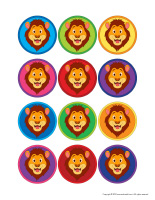
Cooking:
- Frozen bananas on a stick or bananas dipped in chocolate for a “monkey snack”.
- Prepare a meal children can eat like animals (without utensils, using their hands).
TRANSITION ACTIVITIES
This is my spot-The jungle
(Open game-This is my spot-The jungle) Print two copies of each illustration. Deposit one illustration on the table and cover it with Mac-Tac. Place the other copy in a bag. Children take turns picking an illustration to determine their spot at the table for the day. You can also use them to determine naptime spots or their place in the task train.
Follow the animal tracks
(Open jungle animal tracks) Print as many tracks as you need. Use contact paper to secure them on the floor and create a path which leads to various areas within the daycare. You can ask children to make the corresponding animal sounds as they walk on the tracks.
Animal walks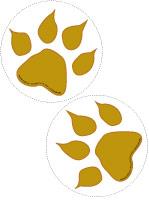
Walk around the daycare with your group imitating various types of animals. Try a different animal every time you change activities.
ACTIVITIES FOR BABIES
Soft animals
Collect several different jungle stuffed animals. Let babies play with them throughout the theme.
Illustrated jungle
Find as many jungle and jungle animal pictures and illustrations as possible. Display them on walls, cupboards, and the floor throughout the daycare. Babies will enjoy exploring the scenes as they move around the daycare.
I am a...
Practice making different animal sounds with babies. Begin with basic animal sounds (dog, cat, etc.) and then try roaring like a lion, making monkey sounds, etc.
Makeup and masks
Paint babies’ faces so they look like the animals you are discovering during the theme. If you prefer, have fun with animal masks.
PHYSICAL ACTIVITY AND MOTOR SKILLS
In the jungle, there are...
Have children stand in a circle. Give each child an animal name (lion, zebra, elephant, giraffe, gorilla, etc.) Stand in the centre of the circle. Throw a scarf up in the air and say, “In the jungle, there are...” (name an animal). The child you name must hurry to catch the scarf. He can then throw the scarf up in the air and name another animal.
Puzzles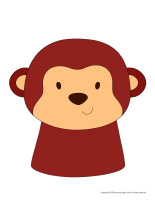
Collect jungle scenes (greeting cards, calendars, etc.) and cut them into two or three pieces using jagged scissors. Give each child one puzzle piece and hide the remaining pieces. Each child must find the missing pieces for his puzzle.
Lacing
(Open lacing-zoo animals) Print and trace onto cardboard. Cut out the animals. Punch holes around the contour using a hole-punch. Children will enjoy threading a piece of yarn through the holes.
The giant giraffe
Provide yellow and brown blocks. Help children stack them to create a long giraffe neck. Keep stacking until it falls down.
I am a panther
Set a balance beam in the center of the daycare. Ask children to walk on it like panthers, lions, tigers, or other feline creatures.
Big like, small like
Divide your group into two teams and have them sit facing each other. Ask one group to name large animals while the other group must name small animals. Have children use big voices and tiny voices (BIG LIKE AN ELEPHANT, small like a mouse).
Silly monkey
Select a child to play the role of the monkey. The other children represent gorillas and lie down on the ground, side by side, with their eyes wide open and a serious face. The child who is the monkey must walk around the gorillas and make silly faces. If he makes the gorillas laugh, they are eliminated. The last gorilla to be eliminated can be the next silly monkey.
Monkey game
Monkeys jump from one branch to another. Have children practice various kinds of jumps. They can hop on one leg, with their feet together, make large jumps, make tiny jumps, etc. Repeat the activity using potato sacks or jumping ropes.
Banana yellow
Ask your little monkeys to collect all the items in the daycare which are yellow like bananas as quickly as possible.
Follow the elephant
Children hold hands. They must follow the rhythm of the first child in line. They must walk slowly or quickly like him, take heavy or light steps, or roll around in the mud to protect themselves from insects. Tell children how elephants can transport people. Ask an older child to crouch down and sit a child on his back. Older children will be proud to give rides to those who are younger.
The monkeys follow the gorilla
Children stand single file. The leader is the gorilla. The gorilla performs various movements and the monkeys imitate him. The gorilla may jump, perform somersaults, raise his arms, crawl, clap hands, spin around, etc.
OUTDOOR ACTIVITIES
Beware of the snake
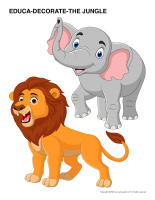
Wave a jumping rope back and forth on the floor to make it look like a snake. Children must jump over the snake without touching it.
Jungle visit
(Open Activity sheet-Assemble the zoo animals) Print and laminate the pictures. Hide them throughout the yard and invite children to search for the pieces. When they have all of them they can assemble the animals. The game ends when all the animals have been found. Variation: Children can also use the cards to create silly animals. For example, they can choose to place the giraffe head with the elephant body, etc.
Zoo
Transform your sandbox to make it look like a zoo. Add several animal figurines, draw paths, use coffee sticks to create fences, plant weeds in the sand to represent trees, add rocks, etc. Children can use their imagination to create a unique zoo.
Animal family
Divide your group into three teams by whispering in each child’s ear which family he belongs to. You may have an elephant family, a monkey family, and a lion family. When you give the signal, children act like the animal they were given to find their family members.
MUSICAL AND RHYTHMIC ACTIVITIES
Crazy jungle
(Open educa-decorate-The jungle) Print. Laminate and secure the illustrations on the floor. Play African music. When the music stops, children must quickly sit on an animal (variation of musical chairs). Before starting the music again, ask each child to make the sound of the animal he is sitting on.
Musical animal
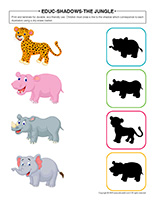
Play music and invite children to dance. When the music stops, show children an animal illustration. They must walk like the animal, act like the animal, and make the corresponding animal sound. When you start the music again, children resume dancing. When the music stops again, show children another animal illustration.
Follow the zookeeper
You are the zookeeper. Children stand single file behind you. Begin with easy movements such as three steps forward, two steps to the right, or one kangaroo hop. Increase the difficulty level as you go along. You may walk backwards, walk on your tiptoes like a giraffe, or take giant steps like an elephant, etc.
COGNITIVE ACTIVITIES
Educ-shadows-The jungle
(Open educ-shadows-The jungle) Print and laminate for durable, eco-friendly use. Children must draw a line to the shadow which corresponds to each illustration using a dry-erase marker.
Educ-math-The jungle
(Open educ-math-The jungle) Print and laminate for durable, eco-friendly use. Children must count the objects in each rectangle and circle the corresponding number.
Educ-same and different-The jungle
(Open educ-same and different-The jungle) Print and laminate for durable, eco-friendly use. Children must circle the illustration which is different in each row.
Hunt and seek-The zoo
(Open hunt and seek-The zoo) Print and laminate. Children pick cards and search for the elements in the scene.
Where do the animals live?
(Open game-Where do animals live) Print and laminate the game. Using Velcro, children must associate the animals to the correct habitat.
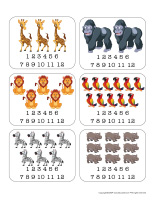
ACTIVITIES INVOLVING PARENTS
Zoo visit
If you are lucky enough to have a zoo not too far away, invite parents to join you for a visit.
MORAL AND SOCIAL ACTIVITIES
Photo booth-The jungle
(Open photo booth-The jungle) Print the various accessories, cut them out, and glue a drinking straw behind each one. Purchase hats, scarves, glasses, etc. at your local dollar store. Create a special decor using a large piece of cardboard or curtain. Invite children to pick the accessories they prefer and pose for you. You can take individual, group, or family photos. Print the pictures and display them on a wall for everyone to see.
Safari in the jungle
Go on a safari in the jungle with your group. Cut brown paper bags to create safari vests (you can even paint them with camouflage designs). Make your own binoculars using empty toilet paper rolls and hide animals throughout the daycare.
Funny monkey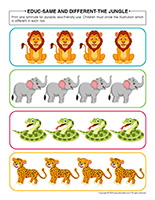
Set mirrors on a table. Encourage children to make funny faces. Have a contest. Who will be the funniest monkey?
Which animal is this?
A child chooses an animal (card or figurine) and hides it in his hands. The object of the game is to describe the animal or act like the animal so that the other children can guess which animal it is. The child who guesses correctly will be the next one to pick an animal.
The lion’s roar
Record lion roars. Enjoy a game of loud sounds and quiet sounds. Produce several sounds with whatever you have on hand. Explore different animal cries with children.
FUN MASKS
I am a lion
(Open lion costume) Print. Glue the design on heavy cardboard and cut it out. If you prefer, you can laminate the mask before cutting it. Add string or elastic so that children can wear the mask on their face.
I am a monkey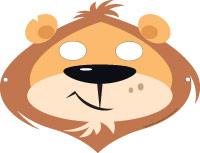
(Open monkey costume) Print. Glue the design on heavy cardboard and cut it out. If you prefer, you can laminate the mask before cutting it. Add string or elastic so that children can wear the mask on their face.
EARLY SCIENCE / EXPLORATION / MANIPULATION
Magnetic animals
Draw small animal shapes on construction paper and laminate them. Glue them on magnetic paper and cut out the shapes. Provide cookie sheets. Children will enjoy creating scenes on the cookie sheets.
I live in the jungle
Deposit a bowl of water, mud, grass, and branches in a large container. Add plastic jungle animal figurines and let children play while exploring the different textures.
From liana to liana...like a monkey
Hang a rope from the ceiling and tie a stuffed animal monkey to it. Children can take turns swinging the monkey. Watch the rope and its different trajectories with your group.
Animal tracks
Use your animal figurines to make tracks in salt dough. Let dry. Ask children to match the figurines to the correct tracks. You can also make tracks in paint, in a sandbox, etc.
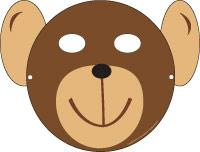
Heavy like an elephant, light like a feather
Ask children to identify heavy toys and light toys. Weigh each child. Provide small scales and weigh various objects.
The elephant’s trunk
Give each child a container filled with water and a drinking straw. Let them blow in the water just like an elephant does with its trunk.
CULINARY ACTIVITIES
Animal food
Purchase animal-shaped cookies. Serve them at snack time and encourage children to name the animals before eating them.
The monkey and the banana
Prepare several different recipes which require bananas with your group (cake, muffins, banana bread, milkshake, etc.)
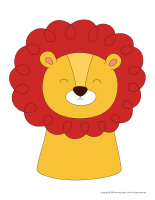
Tiger stripe cookies
Purchase round sugar cookies and cover them with orange frosting. Melt chocolate. Using a toothpick, drip fine chocolate lines on top.
My jungle snack
Use green food coloring to add color to shredded coconut. Deposit the coconut in a small bowl and add animal-shaped cookies on top.
ARTS & CRAFTS
Jungle puppets
(Open puppets-The jungle) Print the different puppet models on cardboard. Have children cut them out and decorate them with a variety of arts & crafts materials. Attach Popsicle sticks to the back.
My crumpled tissue paper jungle
(Open models-jungle animals) Print. Have children fill the animal outlines with crumpled pieces of tissue paper and white glue.
My snake spiral
Have each child paint a paper plate. Once dry (usually the next day), cut the plate like a spiral. Children can draw a face on their snake. Hang the snake spirals within the daycare.
Our jungle map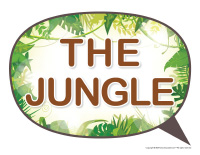
Use a large white banner. With your group, create your own jungle map. Add trees, animals, mountains, etc. You can even ask parents to add to your map.
Parrot...parrot...parrot
(Open models-parrot) Print. Have children add colourful feathers on the model to create beautiful parrots.
My imaginary animal
Invite children to imagine a new type of animal. They can use modeling dough or salt dough to create it. Encourage them to decorate it. When they are done, children can present their animal to the group and share its name, its habitat, its favourite food, etc. with their friends.
Am I an animal?
Have children make a mask with a brown paper grocery bag. Cut openings for their eyes and mouth. Provide feathers, glitter, pipe cleaners, stickers, markers, ribbon, etc. When children are done, they can parade around the daycare to present their animal masks.
My jungle book
Cut animal pictures out of magazines, old books, etc. Glue them on 10 cm x 13 cm pieces of paper. Insert the pages in Ziploc bags, placing two pages back to back in each bag. Staple all the bags together at the closed end so that you will be able to open the bags if necessary. Use colourful adhesive tape to cover the staples. Use ribbon or string to assemble your book.
Lion mask
Have children paint a paper plate and cut the centre out. Use pieces of yellow and brown yarn to create a lion mane around the contour of the plate.
Elephant trunk
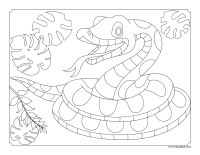
Paint a small paper plate using gray poster paint. Add two gray ears and wiggly eyes. Make a hole in the center of the plate. Children can insert their finger through the hole to represent the elephant’s trunk.
Elephant feet
Mix black and white poster paint with your group. Use the gray paint to make prints of children’s hands on construction paper. Let dry and frame your elephant feet.
Giant giraffe
Hang several brown paper bags on the wall to form a long giraffe neck. Provide black and yellow poster paint and encourage children to add spots to the giraffe using their fingers.
Mask
(Open zoo animal masks) Print and trace the models on heavy cardboard. Invite children to select the mask they prefer.
Zebra
Trace a zebra outline on black construction paper. Let children cut it out and glue pieces of white yarn on it to represent the zebra’s stripes.
Zebra stripes
Encourage children to make original creations with zebra stripes. Simply provide black paper and white chalk.
Zebra paint
Give each child a piece of white waxed paper. Add strips of masking tape. Children paint on the paper with black poster paint. When the paint is dry, remove the masking tape and admire the zebra stripes!
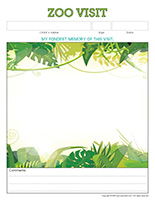
COLORING PAGES
(Open coloring pages theme-The jungle) Print for each child.
CREATIVE COLORING
(Open creative coloring-The jungle) Print for each child.
SCRAPBOOK
(Open scrapbook-Zoo visit) Print for each child. Add the page to each child’s scrapbook.
SONGS & RHYMES
Deep in the jungle
by: Patricia Morrison sung to: Mary had a little lamb
Elephants and monkeys live in
The jungle, the jungle
Elephants and monkeys live
Deep in the jungle
Parrots, snakes, and insects live in
The jungle, the jungle
Parrots, snakes, and insects live
Deep in the jungle
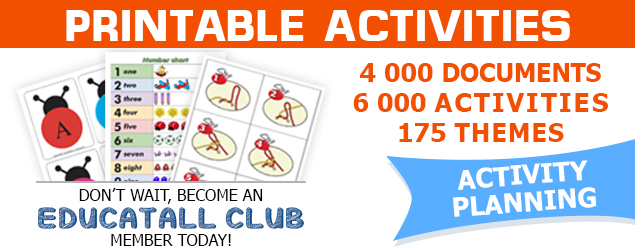
 Home
Home Theme activities
Theme activities
 Babies and toddlers
Babies and toddlers
 Arts and crafts
Arts and crafts
 Science
Science
 Creative recipes
Creative recipes
 Tips and tricks
Tips and tricks
 Special needs
Special needs
 Extra activities
Extra activities
 Educ-TV
Educ-TV
 Newsletter
Newsletter  Online store
Online store Educatall club
Educatall club

